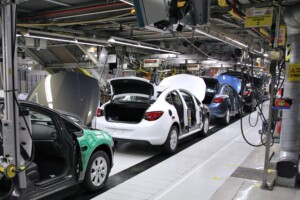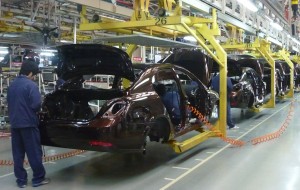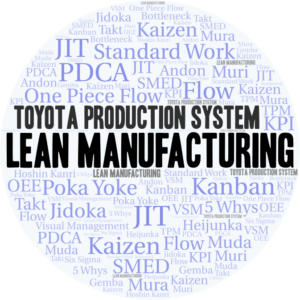 This second post on continuously moving assembly lines will look at the math behind the correlation between the speed of the line (line takt or customer takt), the length of the line, and the amount of work that has to be done on the line. Luckily, the calculations are not very tricky. And, different from a pulsed assembly line, it is perfectly fine to have a continuously moving line that fits not a whole number but a fraction of parts to save space. The tricky part on how to assign the work to the workers will be discussed in the next post of this series.
This second post on continuously moving assembly lines will look at the math behind the correlation between the speed of the line (line takt or customer takt), the length of the line, and the amount of work that has to be done on the line. Luckily, the calculations are not very tricky. And, different from a pulsed assembly line, it is perfectly fine to have a continuously moving line that fits not a whole number but a fraction of parts to save space. The tricky part on how to assign the work to the workers will be discussed in the next post of this series.
Christoph Roser
The Particularities of Continuously Moving Assembly Lines
 Continuously moving assembly lines are commonly found in industry, especially high-volume production. Most final assembly lines in automotive are continuously moving lines, but there are also many more examples in industry. Such lines have many of the same requirements of pulsed or untimed lines, but in a few specific circumstances continuously moving lines can have an advantage. This first post of this small series looks at the basic commonalities and differences between pulsed and continuously moving lines. The next posts looks at the mathematical relation between speed, work content, and line length, before a third post explores in more depth the unique issues of line balancing for continuously moving assembly lines. A final post looks at some unique features for continuously moving assembly lines.
Continuously moving assembly lines are commonly found in industry, especially high-volume production. Most final assembly lines in automotive are continuously moving lines, but there are also many more examples in industry. Such lines have many of the same requirements of pulsed or untimed lines, but in a few specific circumstances continuously moving lines can have an advantage. This first post of this small series looks at the basic commonalities and differences between pulsed and continuously moving lines. The next posts looks at the mathematical relation between speed, work content, and line length, before a third post explores in more depth the unique issues of line balancing for continuously moving assembly lines. A final post looks at some unique features for continuously moving assembly lines.
How to Do Make-or-Buy
 In my last post I discussed how a purely cost-accounting-driven make-or-buy decision can be bad for the company. However, there are often good reasons to buy parts or products instead of make them. In this post I will look at a couple of reasons for outsourcing rather than making it yourself. Unfortunately, all of these are hard to pin down in numbers, and at the end of the day it is still a qualitative decision.
In my last post I discussed how a purely cost-accounting-driven make-or-buy decision can be bad for the company. However, there are often good reasons to buy parts or products instead of make them. In this post I will look at a couple of reasons for outsourcing rather than making it yourself. Unfortunately, all of these are hard to pin down in numbers, and at the end of the day it is still a qualitative decision.
Make or Buy: How Not to Do It
 “Make or buy?” is a question most companies have to ask themselves. Which parts or even products should you make yourself, and which ones should you outsource to a third-party supplier? The question itself is already difficult, but here again we run into the problem of cost accounting. If you go purely by the numbers, you can easily run your company into the ground. Let me show you how (NOT) to do it.
“Make or buy?” is a question most companies have to ask themselves. Which parts or even products should you make yourself, and which ones should you outsource to a third-party supplier? The question itself is already difficult, but here again we run into the problem of cost accounting. If you go purely by the numbers, you can easily run your company into the ground. Let me show you how (NOT) to do it.
Flexible Multi-Model Assembly Line at Toyota
 The flexible assembly line at Toyota is a well-known manufacturing approach. Such a flexibility gives Toyota the ability to produce different models in almost any sequence. These lines were already common at Toyota around 1990, and by now they are found at many car makers. Time to take a look at how it is done and why it is good.
The flexible assembly line at Toyota is a well-known manufacturing approach. Such a flexibility gives Toyota the ability to produce different models in almost any sequence. These lines were already common at Toyota around 1990, and by now they are found at many car makers. Time to take a look at how it is done and why it is good.
Training Within Industry—Second-Line Supervisor Job Instructions
 Training Within Industry and its modules Job Instructions, Job Relations, and Job Methods are well known. But (thanks to Mark Warren) I just recently learned about another module: Job Instructions for Second-Line Supervisors (nowadays called managers). This is a hierarchy level higher, and the goal is to support and guide the shop floor supervisors on how to use job instructions. Let me dig deeper:
Training Within Industry and its modules Job Instructions, Job Relations, and Job Methods are well known. But (thanks to Mark Warren) I just recently learned about another module: Job Instructions for Second-Line Supervisors (nowadays called managers). This is a hierarchy level higher, and the goal is to support and guide the shop floor supervisors on how to use job instructions. Let me dig deeper:
Real vs. Planned Data in Pull Systems
 Pull systems like kanban and reorder point are a cornerstone of inventory management and fluctuation reduction in lean manufacturing. The production is managed based on ACTUAL consumption. Theoretically, it is also possible to include expected but not yet actual consumption. In this post, I will explain to you the concept behind it and why I think it is a bad idea…
Pull systems like kanban and reorder point are a cornerstone of inventory management and fluctuation reduction in lean manufacturing. The production is managed based on ACTUAL consumption. Theoretically, it is also possible to include expected but not yet actual consumption. In this post, I will explain to you the concept behind it and why I think it is a bad idea…
The Difference between the Toyota Production System and Lean Manufacturing
 The Toyota Production System (TPS) is the archetype of lean manufacturing. Lean is often used as a synonym for the Toyota Production System, and that is generally quite accurate. It is also sometimes referred to as the “Westernized” version of the Toyota Production System. However, there are some smaller differences in the underlying approach, as well as some larger and often unintentional differences in its application. Let’s have a look!
The Toyota Production System (TPS) is the archetype of lean manufacturing. Lean is often used as a synonym for the Toyota Production System, and that is generally quite accurate. It is also sometimes referred to as the “Westernized” version of the Toyota Production System. However, there are some smaller differences in the underlying approach, as well as some larger and often unintentional differences in its application. Let’s have a look!
